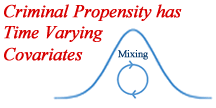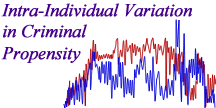Criminal Propensity has Time Varying Covariates
Criminal Propensity is Varying Over Time
An important part of the solution to the criminological puzzle requires an understanding of the time varying facets of criminal propensity. There are two main sources of variation over time, development and intra-individual variation. These two time varying covariates create a mixing effect in the criminal propensity distribution. Criminologists need to spend more time focusing on research related to this mixing effect.

Criminal Propensity has Time Varying Covariates
There are two main classes of time varying covariates that create a mixing effect in in the normal distribution of criminal propensity. The first is human development. The person’s capacity to commit crime, as well as their ability to avoid crime, is varying substantially over the life course. The second class of time varying covariate will be called “intra-individual variation,” but the net effect could also be called fluctuation. People’s minds are changing from second to second, and this means that their internal and external perceptions are changing constantly. this constant fluctuation in brain functioning leads to ongoing changes in behavior. If all of the random effects in a person’s life are combined, there are substantial sources of intra-individual variation in the average individual’s propensity for crime.

How Development Affects Criminal Propensity
There are two primary developmental factors that affect the level of criminal propensity over the life course, and these are strength and mental capacity. Strength provides the capacity for crime, and mental capacity provides the ability to control one’s behavior and avoid committing criminal acts. While there are other important sources of variation in criminal propensity, it must be recognized that development creates both positive and negative influences on the level of criminal propensity over the life course.

Intra-Individual Variation in Criminal Propensity
One of the more puzzling facets of criminal propensity is its variation over time. Various terms have been used to describe this phenomenon including zig-zag, drift, ambivalence, etc. The common term for this type of phenomenon is intra-individual variation. The reasons for intra-individual variation in criminal propensity have not been fully explored, but the fact that it exists must be accounted for in a theoretical model of propensity, sanctioning, and crime. Failure to account for intra-individual variation could lead to serious problems with models designed to control criminal propensity in the population. It will be suggested that current trait theories of personality, where “traits” are seen as collections of “states,” provides a new way of looking at the criminal propensity distribution.
